Tomato Hornworms: Identification and How to Get Rid of Them
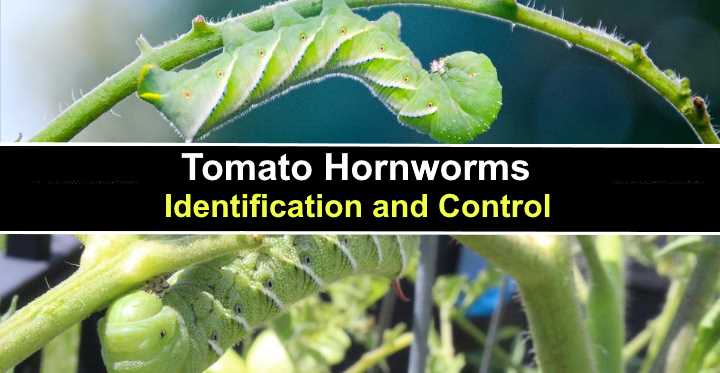
The tomato hornworm is a large green caterpillar with a horn-like tail that does tremendous damage to tomato plants. The hornworms have distinctive creamy-white V-shaped stripes along their sides. However, the destructive caterpillars can be challenging to spot on tomato plants because their green color blends in with tomato foliage.
Getting rid of tomato hornworms for good isn’t easy. It takes patience and vigilance to spot the giant fat green worm-like insects. Usually, handpicking the worms and dropping them in soapy water is the most effective way to eradicate them. However, there are several ways to prevent tomato hornworms or control their numbers.
This article is a guide to identifying fat green tomato hornworm caterpillars that damage tomato plants. Pictures and descriptions of the pale green hornworms will help spot them before they do too much damage. In addition, you’ll get handy tips on getting rid of hornworms for good.
What are Tomato Hornworms (Manduca quinquemaculata)?
Tomato hornworms are large, green caterpillars, growing up to 4 or 5 inches in length, known for their voracious appetite. These common garden pests can cause severe damage in vegetable gardens, particularly in midsummer.
Tomato hornworms can defoliate tomato plants, leaving them stripped of foliage and vulnerable to sunburn. In severe infestations, they may also feed on the green fruit of tomato plants, causing direct harm to the crop. They also feed on other plants in the Solanaceae family, including peppers, potatoes, and eggplants.
Tomato hornworms undergo complete metamorphosis, transitioning from egg to larva (caterpillar) to pupa and, finally, to an adult sphinx moth. After feeding and growing as caterpillars, they burrow into the soil to pupate and eventually emerge as moths.
Tomato hornworms develop into large, robust moths known as “tomato hornworm moths” or “five-spotted hawkmoths” (Manduca quinquemaculata). These moths are brown heavy-bodied insects with a wingspan of around 4 to 5 inches. They and feature distinctive yellow spots on the sides of the abdomen.
Natural predators of tomato hornworms include various birds, such as sparrows and finches, as well as beneficial insects like parasitoid wasps, which lay their eggs on the caterpillars.
Tomato hornworms are sometimes confused with the closely related tobacco hornworm, which has subtle differences in body markings. Both caterpillars look similar and can feed on similar host plants.
How to Identify Tomato Hornworms (Manduca quinquemaculata)
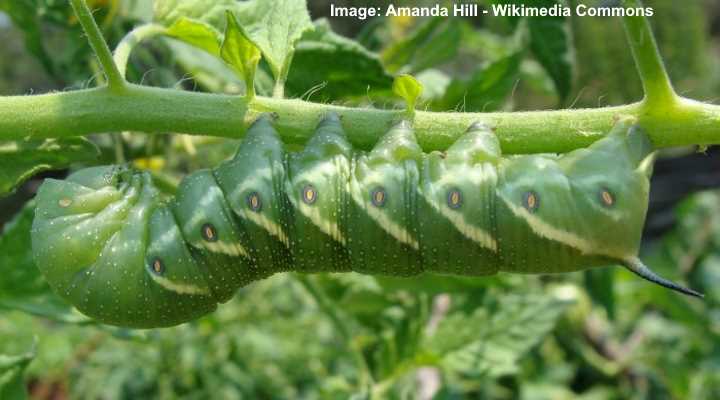
Tomato Hornworm (Manduca quinquemaculata)
Tomato hornworms are large caterpillars with green bodies, a bluish black tail-like horn, and white V-shaped stripes along each side. The plump green hornworms can measure up to 5” (127 mm) long. They also have five pairs of large prolegs on their central segments and an enlarged head curled inward.
Tomato hornworms get their name from the black or dark blue pointed protrusion at their rear. The color of this tail-end helps to tell the tomato hornworm apart from the related tobacco hornworm. The tail of the tomato hornworm is dark blue, whereas the tobacco hornworm has a reddish, horned tail.
Another way to identify the pale green tomato hornworm is the V-shaped yellowish-white stripes along its sides. Close up, you’ll notice small eye-like markings in the apex of the white V-shape. There are also eyespots on either side of its head to help ward off predators.
Tomato hornworms leave behind dark droppings, known as “frass.” You may find these droppings on leaves or the ground near where they are feeding.
Tomato hornworms can be challenging to identify on plants because they blend in well with their environment. However, if you spot one under the leaves or crawling on the stems, you can safely remove the caterpillar by hand.
Tomato hornworms are harmless and won’t sting you, despite their stinger-like tail, and they are not venomous to humans.
Signs of a Tomato Hornworm Infestation
One of the first signs of a tomato hornworm infestation is extensive defoliation. The caterpillars can quickly strip tomato plants of their foliage, leaving behind denuded stems and branches. This defoliation not only impacts the plant’s ability to photosynthesize but also makes the fruit more vulnerable to sunburn.
Bare Stems and Feces: As they feed, tomato hornworms often leave telltale signs behind. You might notice bare stems and branches where the caterpillars have feasted. Also, they typically excrete large amounts of dark droppings called “frass,” which can be another indicator of their presence.
Chewed Fruit: In severe infestations, tomato hornworms can also feed on the green fruit of tomato plants, causing direct damage to the crop. Their chewing results in irregular holes or scars on the surface of tomatoes.
Other Affected Plants: Tomato hornworms are not exclusively tomato-eaters. They also feed on other plants in the Solanaceae family, which includes peppers, potatoes, and eggplants. So, if you grow any of these hornworm hosts nearby, you might find these caterpillars on them as well.
Tomato Hornworm Vs. Tobacco Hornworm
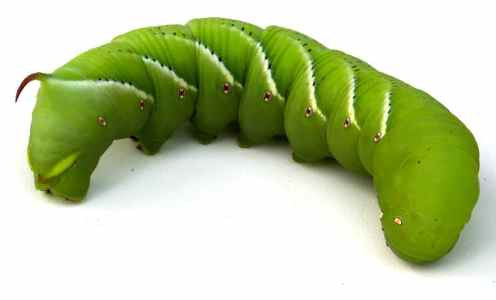
Tobacco Hornworm (Manduca sexta)
Visually, the tomato hornworm (Manduca quinquemaculata) and the tobacco hornworm (Manduca sexta) look similar. The differences are in tail color and distinctive markings.
The tomato hornworm has a dark blue-black horn, while the tobacco hornworm’s horn is reddish.
The tomato hornworm has distinctive white V-shaped markings along each side, with small eye-like markings in the apex of the white V-shape. On the other hand, the tobacco hornworm has white diagonal white stripes on its sides, giving it a different appearance. The adult moth is known as the Carolina sphinx moth or tobacco hawk moth.
Life Cycle of Tomato Hornworms
The tomato hornworm life cycle consists of four phases — egg, caterpillar (larva), pupa, and adult moth. The eggs hatch about seven days after the female lays them. From when the caterpillars hatch until they are full grown it takes around four weeks, and the adult moths live for 10 to 30 days.
Hornworm eggs are tiny, pale green to white oval balls measuring around 0.039” (1 mm). Once the eggs hatch in late spring, the larvae start feeding on tomato plant leaves. They go through five instars (growth stages), during which they shed their skin and grow up to 4” or 5” (100 – 127 mm).
During the larval stage, tomato hornworms generally stay on the same plant, devouring the leaves thanks to their voracious appetite. Through most of the larval stages, the tomato hornworm retains its identifying features — creamy white V-markings and a black horn tail.
The third stage of the tomato hornworm life cycle is when it goes underground to pupate. The pupa is a large, reddish-brown segmented cigar-like object with a loop at one end.
As winter approaches, mature tomato hornworms look for suitable soil to burrow into and overwinter in the pupal stage. This means they stay dormant in the soil, protected from cold temperatures, until the warmer weather of the following spring signals their emergence as adult moths. It’s during this time that they undergo metamorphosis and transform into their final adult form.
After emerging from the pupa, the tomato hornworm turns into the five-spotted hawkmoth. This large brown and gray robust-bodied moth has a wingspan of 5” (13 cm).
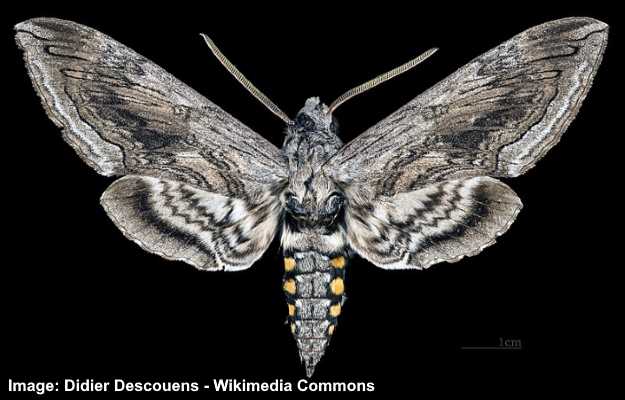
Five-spotted hawkmoth (Manduca quinquemaculata)
Tomato Hornworm Damage
As their name suggests, the tomato hornworm favors tomato plants and can quickly devour entire leaves, small stems, and even parts of the immature fruit. When these destructive garden pests attack the fruit, they leave large scars on tomatoes.
However, these ravenous caterpillars will also gorge on eggplant, potato, tobacco, and pepper leaves — all plants from the nightshade family Solanaceae.
However, it’s good to note that tomato hornworms are not dangerous to humans. You can safely pick the worms up without fear of being stung. Additionally, despite their insatiable appetite, the green hornworms won’t bite humans, and their black tail isn’t a stinger. Therefore, physically removing them is the best way to prevent damage.
But how can you tell if tomato hornworms are attacking your greenhouse crops? Here are some tell-tale signs that the large caterpillars are devouring your tomato plants.
Tomato hornworms destroy leaves
The first sign of tomato hornworm damage is holes appearing in your tomato plant leaves. This usually occurs in late spring, just after the harmful larvae have hatched. Unfortunately, the pesky caterpillars are hard to spot after they have hatched because they are so tiny.
As they grow, the plant-destroying worms strip the upper leaves on a tomato plant until only the stems remain. Other evidence of tomato hornworm activity is devoured flowers, complete defoliation, and open wounds on tomato fruits. The hungry caterpillar can consume a 1-ft. (30 cm) long tomato leaf in a day.
Tomato hornworm droppings
Droppings from tomato hornworms look like dark green or black dry, crumbly barrel-shaped substances. The tomato hornworm poop resembles tiny coffee beans or small black pellets. If the hornworms are causing damage, you’ll find the black or green droppings on the top of the leaves.
Tomato hornworm damage fruits
Unfortunately, not even your prized tomatoes — ripe or unripe — are safe from tomato caterpillar damage. Caterpillars, in their final instars, may start eating tomatoes. They will eat away the skin and some of the flesh, leaving behind large, deep scars on tomatoes. A large tomato hornworm can devour several tomatoes in a short time.
How to Protect Plants From Tomato Hornworms
Prevention is critical when it comes to protecting tomato plants from the destructive effect of hornworms. For example, it’s vital to check tomato leaves for signs of eggs and then wipe down the leaves to remove them. However, this may not always be successful because the small pale oval eggs are exceedingly tiny.
The most common way to protect tomatoes from caterpillar activity is to check the plants every few days for the nasty bugs. Despite their camouflage, they should be easy to locate due to their large size.
How to Control Tomato Hornworm
Keeping tomato hornworms away from your greenhouse crops and tomatoes requires a multi-faceted approach. In most cases, it’s best to control tomato caterpillar populations using natural methods. This reduces exposure to harmful and toxic chemicals and prevents the voracious larvae from building up resistance to pesticides.
Here are some effective methods that many gardeners have found helpful in controlling tomato hornworms.
Beneficial insects are effective for tomato hornworm control
Predatory insects like ladybugs, green lacewings, trichogramma parasitic wasps, and braconid wasps are effective in controlling hornworm numbers. The beneficial insects prey on caterpillar eggs and larvae, devouring them before they get a chance to do damage.
Other beneficial insects parasitize tomato hornworms. For example, parasitoid wasps lay their eggs inside larvae. The eggs hatch inside the caterpillars and then feed on the hornworm’s inside until they pupate. The larval pupae look like little grains of white rice stuck to the caterpillar. Once the adult wasps hatch, they kill their host — the dreaded tomato hornworm.
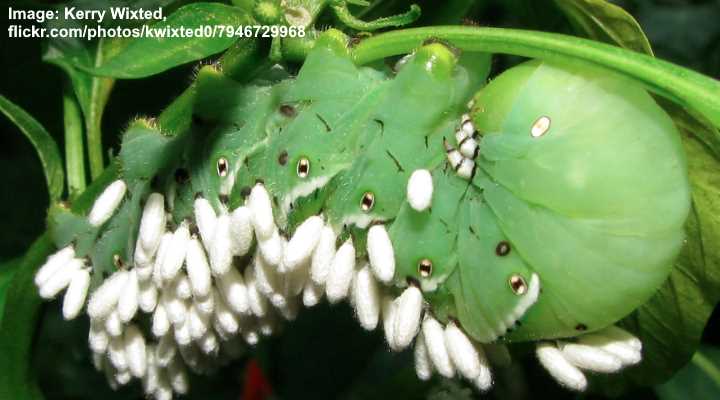
Tomato hornworm caterpillar with parasitoid wasp pupae on its back
Therefore, if you see a tomato hornworm on your plants and have many tiny white sacs attached, it’s best to leave the caterpillar alone. The parasitoid wasps will soon hatch and kill the weakened caterpillar. They will then search out other caterpillars to parasitize and help keep your plants free from hornworms.
Have good weed control practices to control tomato hornworms
Tilling the soil in the fall is a highly effective way to eradicate tomato hornworms from your yard. This control method is helpful because caterpillars burrow into the ground after harvest to overwinter. Tilling after you have harvested your tomatoes and before you plant new ones will disrupt the caterpillar’s life cycle, destroying most of the larvae in the ground.
Crop rotation for tomato hornworm control
A tried and tested method for organic pest control is to rotate crops every other year. This cultural control method is beneficial if you were plagued by tomato hornworms the previous year. Then, all you need to do is plant your tomatoes in a new location. This helps prevent overwintering hornworms from emerging too close to plants to lay their eggs.
Mulch can help prevent tomato hornworm larvae from emerging
A thick layer of mulch around your newly-planted tomato plants can help keep the destructive caterpillars at bay. The mulch helps prevent the larvae from emerging from the soil and laying eggs on your nightshade plants. Some vegetable gardeners recommend black plastic to create a solid barrier. Alternatively, you can lay down a thick layer of straw.
Mulching also has a beneficial effect on your crops in general. First, the layer of organic mulch can help keep the ground cool, aid moisture retention, and prevent weeds from emerging. Of course, you also have the added benefit of controlling nasty bugs that overwinter in the soil.
How to Get Rid of Tomato Hornworms
The easiest way to eradicate large fat tomato caterpillars from your plants is to remove them by hand. However, there are also ways to kill off tomato hornworms during most stages of their life cycle. For example, natural insecticides like bacillus thuringiensis, neem oil, and insecticidal soap can be effective against hornworm eggs and emerging larvae.
Handpick tomato hornworms to eradicate them
Removing tomato hornworms by hand is usually the easiest way to kill them. Despite their pale green appearance acting as camouflage, you can generally spot the huge worms during a careful inspection. Hornworms are harmless and won’t sting or bite. Pick each worm up and drop it into a bucket of hot soapy water to destroy them.
Check for tomato hornworms twice weekly to limit plant damage in your greenhouse or yard.
Neem oil kills tomato hornworm eggs and tiny larvae
Spraying neem oil can be one of your practical tools in your battle with the green beasties. Neem oil works on bugs because it contains a natural insecticide that disrupts a caterpillar’s life cycle. Neem oil spray inhibits larvae development and growth. In time, the caterpillar eggs and larvae die.
To apply neem oil to your tomato plants, combine 2 tsp. neem oil and 1 tsp, liquid Castile soap with 1 quart (1 l) of water. Mix the neem oil solution well in a spray bottle and liberally douse your tomato plant leaves. Apply the natural pesticide every seven days until all signs of caterpillar activity have disappeared.
For neem oil to be effective, you should start using it early in the season to target tomato hornworm eggs and the emerging larvae. However, combining the neem oil spray with other hornworm control methods is vital if you want to eliminate the caterpillars from tomato plants completely.
Insecticidal soap kills tomato hornworms
Spraying insecticidal soap is another effective way to kill tomato hornworms. Insecticidal soap is a natural bug control method that works by suffocating small larvae and breaking down their protective outer layer. This way, the soap residue helps to dehydrate the caterpillars, resulting in their death. In addition, using insecticidal soap is effective for wiping down tomato plant leaves to remove eggs.
You can make the soap spray using a brand like Dr. Bronner’s or Ivory Snow. You should use up to three tablespoons for every gallon (3.4 l) of liquid. After combining the soap and water, spray the solution on both sides of the leaves and spray any visible caterpillars. Insecticidal soap must come into contact with the garden pests to be effective.
Alternatively, you can buy commercially produced organic insecticidal soap for tomato hornworm eradication.
Bacillus thuringiensis (Bt) gets rid of tomato hornworms
Using a low-risk natural pesticide like bacillus thuringiensis (Bt) can help get rid of pesky tomato caterpillars for good. The bacteria strain to use is Bacillus thuringiensis var. kurstaki which targets caterpillars. You buy the Bt solution and follow the manufacturer’s instructions for application.
Bacillus thuringiensis is a naturally occurring soil bacteria that won’t harm your plants and other insects such as bees . It only works if the tomato hornworms ingest the solution and it’s most effective on caterpillars less than 2” (50 mm) long. Therefore, you should spray the tomato plant foliage with the solution, especially the underside of leaves for best results.
Spinosad
Spinosad is an effective organic pesticide that can be used to control and get rid of tomato hornworms in your garden.
Apply the Spinosad solution to the affected tomato plants. Make sure to cover the leaves thoroughly, especially the undersides, where hornworms often feed. You can also treat nearby plants as a preventive measure since hornworms can move between plants.
Spinosad remains effective for a period ranging from one to two weeks. However, it’s essential to be cautious around bees when using Spinosad while it’s still wet, as it can be toxic to them during this state.
Related articles:
